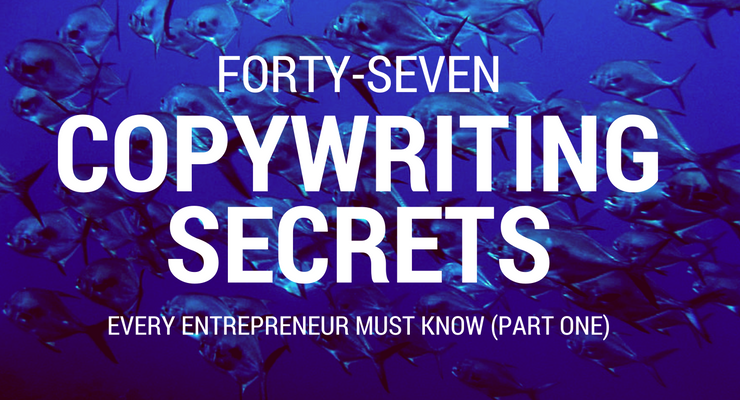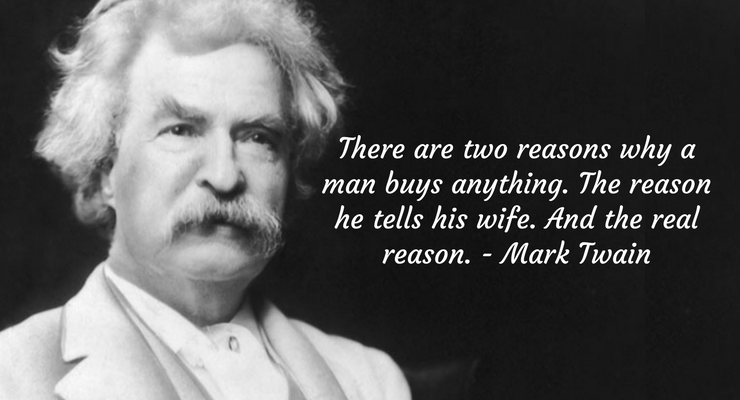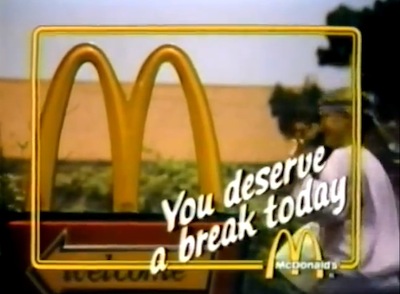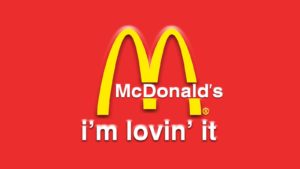
Pop quiz!
What’s one of the most profitable skills you can develop as a freelancer or entrepreneur?
Answer:
Get better at copywriting.
Why?
Simple:
Because copywriting is persuasion in print.
And when you improve your ability to write persuasively:
- More prospects will say “Yes!” to your offer … instead of leaving your website never to return.
- More visitors will read, like, and share your posts … instead of bouncing off your blog and back to Facebook.
- More clients will respond to your job proposals … instead of ignoring your emails.
Can you see how the ability to write persuasively will benefit your business?
You can?
You’re nodding your head in agreement right now?
Then have I got some good news for you …
You’re About To Get A Whole Lot Better
At Persuasion In Print!
Finish reading these copywriting secrets and you’ll have have a grasp of …
- How to understand what your prospect really wants from you — and why that’s critical to the success of every piece of copy you write …
- How to tap into the emotions that compel your reader to take action — be it clicking a link, picking up the phone, or whipping out their wallet …
- 3 questions that transform the features of your offer into benefits your prospect will move mountains to experience in his life …
- The “Rule Of One” and how to use it to magnify the persuasiveness of your writing — (McDonald’s used this powerful rule to become the biggest restaurant franchise in the world) …
- And more!
This is a beefy 8,000+ word article. So to make it easier for you to read I’ve decided to publish it in three parts.
Part One (which you’re reading now) focuses on the one person who will determine whether what you write is a rousing success or a big waste of time: your prospect.
You’ll soon discover some very powerful ways to “walk in your prospect’s shoes” so you can write copy that speaks to her needs, wants, hopes, desires, and fears.
You’ll also discover three powerful persuasion techniques.
These three little-known techniques are true copywriting secrets.
Master them and they’ll put your copy head and shoulders above 90% your competition.
Part Two shows you how to write attention-gaining headlines and captivating body copy. Essential skills if you want to both GAIN your reader’s attention and MAINTAIN it over the course of your copy.
Part Three focuses on irresistible offers that compel your reader to take action — be that sharing your blog post, contacting you to book a consultation, or purchasing your offer.
One more thing:
You’ll notice quite a few quotes as you read.
These quotes are copywriting secrets from advertising legends of the past like Claude Hopkins, Robert Collier, John Caples, David Ogilvy, and Rosser Reeves … along with living legends like Dan Kennedy, John Carlton and Joe Sugarman.

Not my actual copywriting library… but I WISH!
The books and writings of these ad giants are the foundation of my education as a copywriter.
They’ve helped me generate many millions of dollars in sales for my clients and a comfortable living for myself and my family. I know you’ll find great value in their insights as well.
Ready to learn 47 of the most powerful secrets of persuasive writing? Alright — let’s do this!
47 Copywriting Secrets
Every Entrepreneur Must Know
1. ALWAYS Start With Your Prospect
Every word of copy you write (and for the purposes of this article “copy” applies not only to advertising but also to a blog post, business proposal, “About” page on your website — any form of persuasive writing), every word of it has to be in the service of your prospect.
From the very first word, make your copy about your prospect.
This is something that many (if not most) businesses and entrepreneurs get wrong.
You see it all over the Internet.
Website after website crowing about how long they’ve been in business … how big they are … or (gag) some variation of “We’re the best!”
Now, your wife or mother may be impressed by such boasts, but … your prospect is not.
Your prospect wants to know how your offer is going to make him better off.
Stop thinking about your need to make the sale. Instead, think about your reader’s need to reduce the B.S. in his life.” — John Carlton
And in order to help your prospect reduce the B.S. in his life, you must first understand exactly what problems keep your prospect up at night.
A quick and easy way to do that is …
2. Read Your Prospect’s Diary
Do you want to gain your reader’s immediate attention?
Easy:
Talk to him about his problems using the same words and expressions he uses to describe his problems to himself.
You need to enter the conversation going on in your prospect’s mind.
When your prospect reads your sales letter, blog post, email, or ad you want her to feel like she’s reading a page out of her diary.
You want her to feel, deep in her gut, that you understand her problem so intimately, so completely, she’d be foolish not to listen to what you have to say.
Let me show you how to get your prospect to share her most private pain with you:
Say you’re in the health market. And you want to promote a fantastic blood sugar supplement.
Open up Google in your browser and type “what it feels like to have diabetes forum”.
Click any of the links that pop up.
Voila.
You now have access to THOUSANDS of your ideal prospects, all describing in their own words, exactly what it’s like to struggle with diabetes.
Online forums are like diaries with the covers flung wide open.
It’s where people go to make their most private thoughts public.
Go into these forums with an open ear, caring heart, and the right questions to ask and your prospect will tell you precisely what problems you can solve for her.
Key Takeaway: Google the phrase “what does it feel like to [PROBLEM] forum”.
Use what people are talking about in these forums to write copy that speaks in your prospect’s voice to her most painful problem.
3. The 21 Questions You Must Ask About Your Prospect
Remember:
Your prospect is busy. Stressed. And selfish.
Just like you and me.
Unless you speak to her needs, hopes, desires, or fears she has no reason to pay any attention to you.
You’re just more of the noise she wants to tune out.
But show your prospect that you understand what she’s going through and want to help? Now you have her undivided attention.
You can ask these four questions to better understand your prospects’ pain points so you can present yourself as the perfect solution to her problems:
- How does this problem make you feel?
- What have you tried in the pasts to solve this problem?
- What is your biggest fear? What makes you toss and turn in bed at night?
- If you could invent a product or service to solve this problem, what would it do?
Don’t try to answer these questions yourself. Listen to your prospect. Let what she says inform every word of the copy you write.
Here’s the deal:
Your sales copy, blog post, email, or anything else you write is doomed to failure unless it speaks directly to your prospects’ needs.
Drop the ball here and all the time you invested in writing your copy will be wasted.
You don’t want that, right?
Me either.
That’s why I created a handy guide, “21 Questions To Identify Your Prospects’ Hidden Needs”, you can download by clicking here.
4. Write To A Single, Specific Individual
If you write to everyone, you write to no one.
It’s a real flesh and blood person who will say “yes” or “no” to your offer. So write to that person and that person alone.
Don’t think of people in the mass. That gives you a blurred view. Think of a typical individual, man or woman, who is likely to want what you sell.” — Claude Hopkins
Picture yourself sitting knee-to-knee and nose-to-nose with your prospect. Now read your copy out loud.
Does your copy sound like a conversation you’d have with this person in real life? If it doesn’t you need to keep working on it till it achieves that intimate, conversational tone.
5. The Most Powerful Question You Can Ask About Your Prospect
“What does my prospect need to believe about [MY OFFER] in order for her to buy?”
That’s the million dollar question. And it needs to be the burning pillar of fire that guides you as you research and write your copy.
If he’s prepared to believe, he’s prepared to buy.” — Eugene Schwartz
And remember: Don’t try to guess your way to the answer. That’s a risky game to play. It’s easier and far more profitable to simply listen to your prospect. Let what she says about her own personal experience inform your answer.
6. Sell To The Heart, Not The Head
Mark Twain once said:

Most of us like to think we’re rational, logical creatures. But Mark Twain understood that while we may justify our decisions with logic, what actually sparks action is emotion.
If you want to persuade your reader to action, then you must sell to the heart, not the head.
And the way to do that is to translate the features of your product, service, or offer into benefits.
7. Translate Features Into Benefits
Every product has certain features: it’s size, shape, color, how long it’s been around, delivery method, how it’s manufactured, etc., etc., etc.
Your prospect doesn’t really care about any of that. Your prospect is only interested in how your offer will make her life better.
There is just one reason why anyone ever reads a letter you send him. He expects a reward.” — Robert Collier
Make your copy all about the benefits.
Benefits show the reader what’s in it for her. They move her through your copy and create a psychological link between her desires and your offer.
Try this:
Grab a sheet of computer paper and draw a line down the middle.
On the left side of this sheet of paper write down the features of your product. Now ask these three questions about each feature to dig out the benefits.
How does this feature …
- Ease fears?
- Dissolve frustrations?
- Grant desires?
Write down the benefits for each feature on the right side of your sheet of paper. Don’t stop at one, two, or even three benefits per feature.
Dig deep!
Listen to your prospect and search for all of the ways the features of your product or service can reduce the B.S. in her life.
8. Show What Your Offer Does, NOT What It Is
Your prospect absolutely, positively DOES NOT care about what your product is. She cares only about what it does.
This is an essential element to all effective copy. And it’s missing from so much of the copy you read (especially online) that it bears repeating.
When you write to your prospect focus on:
- Not the car — but how prestigious he’ll look behind the wheel
- Not the gym membership — but the surge of confidence he’ll feel with thick, muscular arms bulging out of his sleeves
- Not the coaching program — but the pride and independence he’ll experience after following its advice
Key Takeaway: Every product or service has certain features that describe what that product or service is.
You speak to your prospect’s emotions and move him to action when you SHOW what those features will do to make his life better in some specific way.
9. Make Your Copy Memorable With A “Big Idea”
Persuasive writing is driven by a single big idea.
In 1970, an advertiser named Keith Reinhard came up with the slogan “You deserve a break today” for McDonald’s.

Five words.
But they do a brilliant job of communicating the big idea that propelled McDonald’s to billions of burgers sold and trillions of dollars earned:
You work hard and you have permission to treat yourself right now.
(Ad Age rated “You deserve a break today” the best jingle of the 20th-century.)
Invest every piece of copy you write — be it an email, blog post, love letter, whatever — with a single big idea that appeals to your ideal prospect.
Unless your advertising is built on a Big Idea, it will pass like a ship in the night.” — David Ogilvy
Discovering a good Big Idea is not easy.
In fact, David Ogilvy himself claimed to have only come up with 20-ish Big Ideas his entire career. And he was one of the sharpest marketing minds to ever walk the planet.
A concept this important — not to mention challenging — deserves its own article. Fortunately, A-list copywriter John Forde has published a great write-up of the Big Idea on his blog.
10. The Rule of One
If you’ve been to McDonald’s recently, you know they’re no longer telling folks “You deserve a break today”.
Today, McDonald’s slogan is “I’m lovin’ it”.

Ba-Da-Ba-Ba-Ba
Notice that McDonald’s doesn’t say “You deserve a break today and you’re lovin’ it”.
They stick to ONE idea.
You should do the same.
Build your writing around:
- One powerful idea
- One emotion that compels the reader to action
- One engaging story or interesting fact that supports your idea
- One — and only one — call to action
Your product or service has many benefits to offer your prospect.
Take the article you’re reading right now as an example.
It’s chockablock with 47 different copywriting secrets, but … all of those secrets are focused on ONE idea: to help you become a more persuasive writer.
Imagine:
By the time you’re done with this article more people will pay attention to what you write.
You’ll feel more confident knowing you can get action with the words you write … and won’t it be nice to no longer depend on an expensive copywriter just to update a few pages on your website?
Close your eyes and picture your ideal prospect.
What’s the ONE THING your product or service offers that she wants the most?
How does your offer make her scariest, most painful problems vanish like a wisp of smoke on a warm spring breeze?
Talk about that one thing.
11. Why Would Someone Choose Your Offer Over The Competition?
What’s unique about your product or service?
How is your offer different from the dozens, hundreds, or thousands of similar offers in your market?
In other words:
Why would someone choose your offer over the competition?
This is one of the most difficult questions you will ever ask about your business. It’s also one of the most profitable.
Every product has a unique nature to it — a unique way of relating itself to the customer. If you understand this nature and find the best way to relate the product to the prospect, you’ll hold the key to a successful sales program.” — Joe Sugarman
We call this unique nature your product’s Unique Selling Proposition — or USP.
You ask most folks what makes their offer unique and, after a few seconds of stunned silence, they stammer, “Uh, we’re the best!”
Yeah. And so is everyone else. Which is why pablum like “we’re the best, biggest, #1, etc.” is immediately tuned out.
That pointless puffery won’t do a thing to motivate your prospect to action.
A powerful USP, on the other hand, can help to establish you as the first and only choice in your prospect’s heart.
Tell me if you recognize any of these classic USPs:
- You get fresh, hot pizza delivered to your door in 30 minutes or less or it’s free.
- A diamond is forever.
- We’re number two. We try harder.
- When it absolutely, positively has to be there overnight.
My guess is even though I didn’t include the companies behind these USPs, you recognize most if not all of them.
And that’s the power of a strong USP. It makes you unforgettable.
Let’s have the father of the USP, Rosser Reeves, show us more about this vital concept.
12. You Must Have A Strong Unique Selling Proposition
Rosser Reeves was one of the most successful and influential advertisers of the 20th-century.
Ever watch Mad Men? Don Draper’s professional accomplishments are based in large part off Reeves’ life.
Rosser Reeves is the dude who articulated the concept of the unique selling proposition (USP). In his book, Reality In Advertising, Reeves defined a USP as having three principles:
- Each advertisement must make a proposition to the consumer. Each advertisement must say to the reader: “Buy this product, and you will get this specific benefit”.
- The proposition must be one that the competition either cannot, or does not, offer. It must be unique — either a uniqueness of brand or a claim not otherwise made in that particular field.
- The proposition must be so strong that it can move the mass millions, i.e. pull over new customers to your product.
You probably didn’t realize it, but you’ve grown up with one of Reeves’ most famous unique selling propositions.
In 1941, Reeves sat down with Forrest Mars, of the Mars candy company, to work out a promotion for their new chocolate.
When Reeves asked Mr. Forrest what made this chocolate different from other candies on the market, he said: “They melt in your mouth, not in your hand”.
And — shazam! — one of the most powerful marketing slogans of all time was born.
Check out this 4-minute video clip of the fictional Rosser Reeves giving a powerful real life lesson on how to find your offer’s USP:
You, A Copywriting BOSS!
You now have a better understanding of copywriting than most people in your market … and we haven’t even looked at any actual copywriting techniques yet!
Don’t worry:
We’ll dig deep into the nuts and bolts of the actual writing portion of our copywriting secrets in Part Two and Part Three of this article.
Why spend 3,100 words on your prospect and concepts like the Big Idea, Rule of One and Unique Selling Proposition first?
Simple:
Because before you write a single word of your ad, blog post, or webpage …
You MUST understand who you’re writing to (your ideal prospect) and what you want to tell them (what your offer can do for them that no other offer can).
You’ve seen some proven ways to do that in this article. Your challenge is:
- If you’ve yet to develop a crystal clear picture of your prospect and her deepest desires and fears — do it now!
- If you’ve yet to translate all of the features of your offer into emotion-driven benefits — do it now!
- If you’ve yet to write down a compelling unique proposition for your business — do it now!
Don’t let the time you spent reading this article go to waste. Use what you’ve learned to move your business forward — right now!
One last thing:
Since you’re taking action … if you found these copywriting secrets helpful, would you please share it on social media by tapping or clicking one of the social share icons below? I would really appreciate it!
Leave a Reply